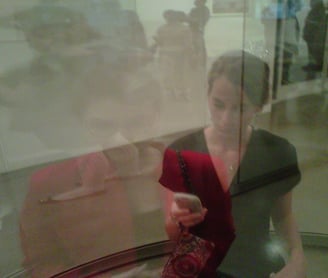As if you didn't feel strange enough at openings...
Dan Graham has found a way to make art openings even more awkward for everyone at Regen Projects in West Hollywood. Bringing double-consciousness to Los Angeles with the help of a pavilion and five architectural models, Graham’s aluminum and glass environments are hybrids of many things — art and architecture, transparency and reflection, inside and outside, subjectivity and objectivity. The situation is such that the viewer sees his reflection and simultaneously sees himself being seen. This doubling that Graham calls “perceiving and being perceived by other people” is made possible by large areas of half-reflective/half-transparent two-way mirror windows and connecting slabs of perforated metal (which function like tiny peepholes, making the metal barriers transparent up close). Graham’s constructions evolve from the simplified forms that corporate office buildings used in the 1970s when Jimmy Carter’s administration punished big businesses, leading corporations to cut costs, and made structural changes to the facade. Corporations literally made their buildings colder by reflecting sunlight with two-way mirrors thus reducing the electrical bill. Although the corporate model for the two-way mirror creates a wholly reflective mirror for the outside party that is a window for insiders, Graham makes it possible for the viewer to see through his mirrors by providing equal transparency on both sides of the glass. In this hybridized model of transparency and reflection, one cannot disappear.
Unlike the asymmetrical corporate model, Graham’s pavilions are emphatically public. Last month, Graham gave an artist’s lecture at UCLA’s Broad Art Center where he alluded to his policy of containment with regards to the pavilions. Graham related his pavilions to other containers of the early modern landscape, like public gardens and telephone booths. The function of these pavilions are paradoxical; they are as much about finding closeness as they are about feeling displaced from the outside world. The public garden seems to be the easiest way to escape the city while still being part of it, just as the telephone booth provides the caller with a faraway voice. Graham’s pavilions draw from these pavilions where the public creates private experience in contained yet transient spaces. His pavilions interrupt smooth subjectivities, splitting them in two. In your reflection, you are not yourself but a distorted version, stretched and magnified like a funhouse specimen. You see the room around you in the arc of a wide mirror, but you can also see through it. Almost the entire room is visible from one point of view, depending on where you stand. Whether you scan the superimposition of your own face on top of so many others or see yourself in the entirety of nothing, you may have yourself an out-of-body experience in spite of psychedelic drugs. In Graham’s pavilions, distortion is as functional as communing with nature in a garden or contacting outsiders by phone (which you can still do if you check out the work and need to call a friend for support or take pictures like me). Take the opportunity to see this show before it ends, preferably at a time when other people are likely to be there or can come with you because it’s not the same without other people there to make it awkward.
Regen Projects II is open Tuesday through Saturday from 10 am to 6 pm in West Hollywood. For more information about this show visit http://www.regenprojects.com/current/


